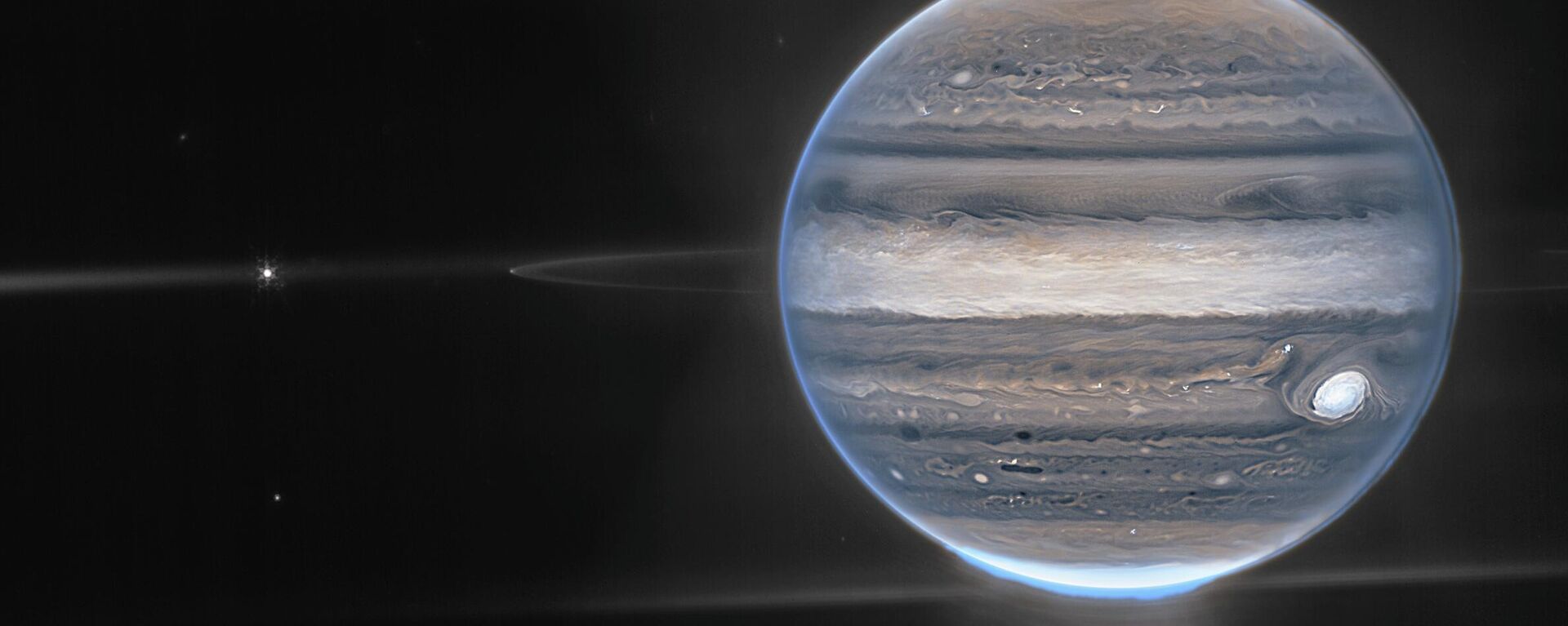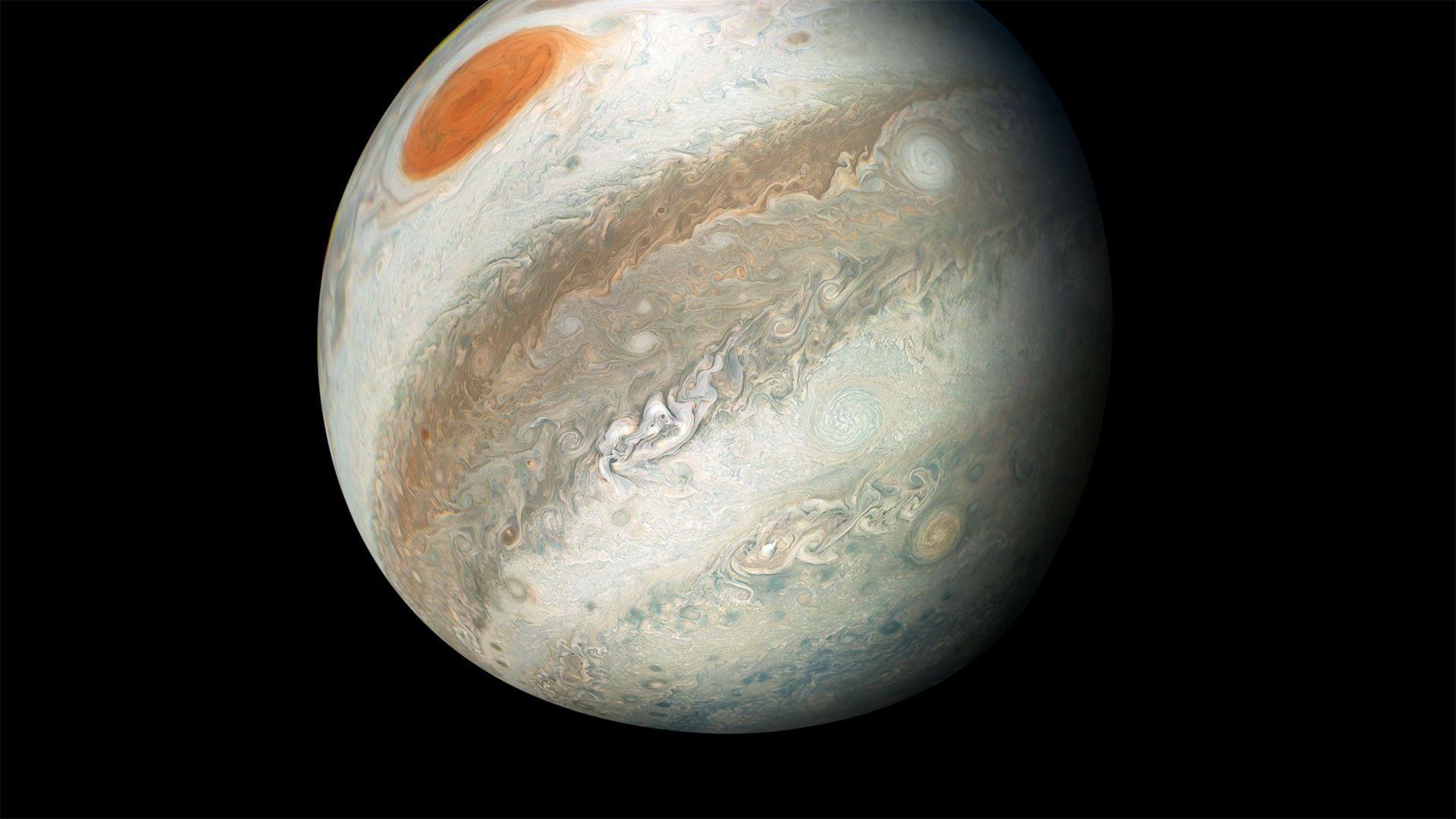https://sputnikglobe.com/20220923/scientists-crack-the-mystery-of-massive-cyclones-forming-polygonal-patterns-on-jupiter-1101132630.html
Scientists Crack Mystery of Massive Cyclones Forming 'Polygonal Patterns' on Jupiter
Scientists Crack Mystery of Massive Cyclones Forming 'Polygonal Patterns' on Jupiter
Sputnik International
Researchers suggest that an "anticyclonic ring" makes it possible for the "polygonal pattern" of cyclones on Jupiter to remain stable. 23.09.2022, Sputnik International
2022-09-23T11:49+0000
2022-09-23T11:49+0000
2022-09-23T13:26+0000
science & tech
jupiter
cyclone
patterns
study
https://cdn1.img.sputnikglobe.com/img/106479/58/1064795807_0:0:1920:1080_1920x0_80_0_0_aa784dbe5eae8eac715714b1a078ce92.jpg
A team of researchers led by Andrew Ingersoll from Caltech has managed to gain new insight into peculiar weather phenomena observed at the poles of the solar system’s largest planet, Jupiter.The phenomena in question are massive cyclones that were first spotted at Jupiter’s poles by NASA’s Juno mission several years ago, and which move in polygonal patterns that seem to remain stable for years.In Jupiter’s north, one cyclone has been detected near the planet’s pole, with eight other cyclones surrounding it in an octagonal pattern; in the planet’s south, there are five more cyclones that “form a pentagon with one at the center,” the study says.In their work, the researchers suggest that this arrangement is essentially made possible by an “anticyclonic ring” located between the polar cyclone and the cyclones that surround it.Their findings, the team says, support the theory that this kind of shielding provided by the “anticyclonic ring” is needed to maintain the stability of the “polygonal pattern”. “However, even at the smallest spatial scale (180km) we do not find the expected signature of convection - a spatial correlation between divergence and anticyclonic vorticity - in contrast with a previous study using additional assumptions about the dynamics, which shows the correlation at scales from 20 to 200km,” the researchers add. “We suggest that a smaller size, relative to atmospheric thickness, of Jupiter’s convective storms compared with Earth’s, can reconcile the two studies.”
https://sputnikglobe.com/20220921/nasa-jupiter-to-reach-its-closest-position-to-earth-in-six-decades-on-september-26-1101024843.html
Sputnik International
feedback@sputniknews.com
+74956456601
MIA „Rossiya Segodnya“
2022
Sputnik International
feedback@sputniknews.com
+74956456601
MIA „Rossiya Segodnya“
News
en_EN
Sputnik International
feedback@sputniknews.com
+74956456601
MIA „Rossiya Segodnya“
Sputnik International
feedback@sputniknews.com
+74956456601
MIA „Rossiya Segodnya“
science & tech, jupiter, cyclone, patterns, study
science & tech, jupiter, cyclone, patterns, study
Scientists Crack Mystery of Massive Cyclones Forming 'Polygonal Patterns' on Jupiter
11:49 GMT 23.09.2022 (Updated: 13:26 GMT 23.09.2022) Researchers suggest that an "anticyclonic ring" makes it possible for the "polygonal pattern" of cyclones on Jupiter to remain stable.
A team of researchers led by Andrew Ingersoll from Caltech has managed to gain new insight into peculiar weather phenomena observed at the poles of the solar system’s largest planet, Jupiter.
The phenomena in question are massive cyclones that were first spotted at Jupiter’s poles by NASA’s Juno mission several years ago, and which move in polygonal patterns that seem to remain stable for years.
In Jupiter’s north, one cyclone has been detected near the planet’s pole, with eight other cyclones surrounding it in an octagonal pattern; in the planet’s south, there are five more cyclones that “form a pentagon with one at the center,” the
study says.
In their work, the researchers suggest that this arrangement is essentially made possible by an “anticyclonic ring” located between the polar cyclone and the cyclones that surround it.

21 September 2022, 02:38 GMT
Their findings, the team says, support the theory that this kind of shielding provided by the “anticyclonic ring” is needed to maintain the stability of the “polygonal pattern”.
“However, even at the smallest spatial scale (180km) we do not find the expected signature of convection - a spatial correlation between divergence and anticyclonic vorticity - in contrast with a previous study using additional assumptions about the dynamics, which shows the correlation at scales from 20 to 200km,” the researchers add. “We suggest that a smaller size, relative to atmospheric thickness, of Jupiter’s convective storms compared with Earth’s, can reconcile the two studies.”


